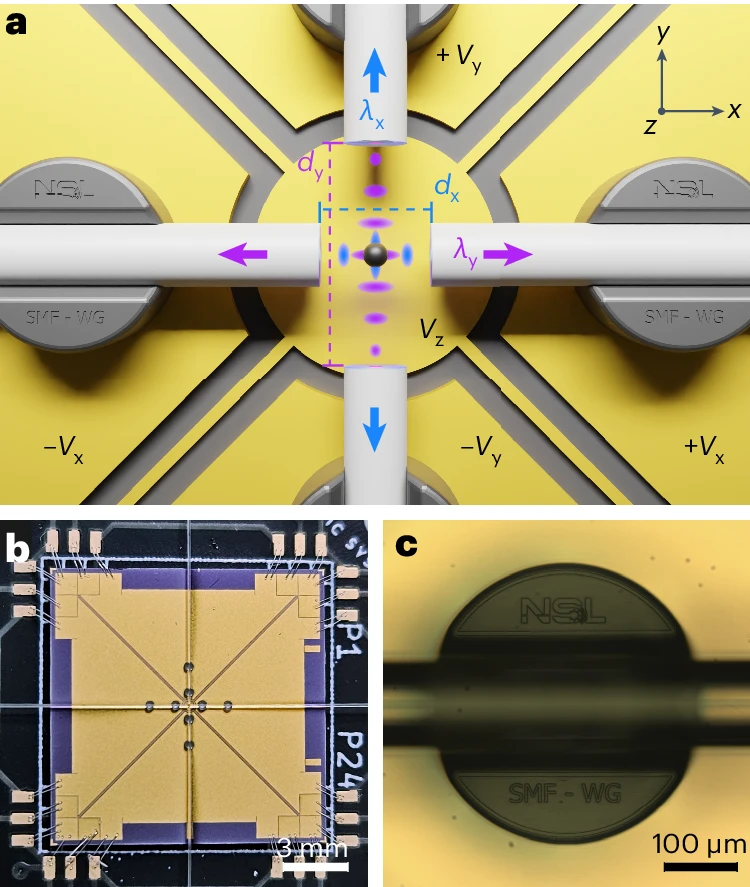Researchers at ETH Zurich have successfully demonstrated the high-vacuum levitation of a silica nanoparticle on a hybrid photonic-electric chip. This significant advance, detailed in their latest study published in Natural nanotechnologyrepresents a major advance in the field of nanotechnology and opens new possibilities for future technological applications.
This breakthrough is the latest in a series of Advances in nanotechnologyprompting some leading futurologists to predict that advances in biotechnology, artificial intelligence and nanorobots will have a significant impact on the future of humanity in the years to come.
“Vacuum levitation has emerged as a versatile technique… (and) it holds great promise for advancing the study of quantum mechanics in the unexplored macroscopic regime,” the study authors wrote. “However, most current levitation platforms are complex and bulky.”
“Here we demonstrate the levitation and motion control under high vacuum of a silica nanoparticle on the surface of a hybrid optical-electrostatic chip.”
The ETH Zurich team’s hybrid chip consists of two layers: an upper photonic layer where the nanoparticle is trapped and detected and a lower electrical layer with planar electrodes for feedback cooling.
This setup allows for precise detection of nanoparticle motion by analyzing scattered light. This method achieves high signal-to-noise ratios without the need for bulky, high-numerical-aperture objectives.
In practical terms, the photonic layer consists of four orthogonally cleaved single-mode optical fibers. These fibers form standing waves that create multiple trapping sites, effectively canceling diffusion forces and ensuring robust particle confinement. The bottom layer uses electrodes for feedback cooling, stabilizing particle motion in three dimensions and enabling precise control.
This hybrid photonic-electric platform enables robust levitation, precise position sensing and dynamic control of the nanoparticle in vacuum without bulky optical equipment.
This compact design could make the technology more practical for real-world applications, including portable devices and confined spaces such as cryostats.
The main advantage of this new vacuum levitation method lies in the integration of optical and electrostatic components on a single chip, allowing high precision and control of the nanoparticle movement.
Although this advance focuses primarily on microscopic particles, the word “levitation” raises intriguing questions about its implications for larger-scale levitation technologies, including advanced propulsion systems.
Microscopic levitation in a vacuum, such as the levitation of silica nanoparticles demonstrated in this recent study, differs fundamentally from the larger-scale levitation that people might associate with science fiction concepts like flying cars or “antigravity.”“ ships.
At the microscopic level, levitation is achieved through precise control of electromagnetic fields and laser cooling techniques in highly controlled environments, usually in a vacuum. These methods aim to counteract the forces acting on tiny particles, allowing them to float or be suspended without physical contact.
In contrast, larger-scale levitation, such as that envisaged for flying vehicles or exotic spacecraft, would require overcoming the gravitational force acting on much larger masses.
This would likely involve entirely different principles, such as magnetic levitation (maglev), which uses powerful magnets to lift and propel vehicles, or potential future technologies that are currently theoretical.
The technical and energy requirements for such large-scale levitation are exponentially greater, and the environmental conditions are more varied and difficult to control compared to a vacuum laboratory setup.
Ultimately, microscopic levitation is a well-studied and practical technique with existing technological applications. Large-scale levitation, such as flying cars or “antigravity“ technologies, remains theoretical.
Rather than trying to achieve levitation, most experts working on next-generation propulsion systems are focusing on concepts such as functionality warp engines and hybrid plasma propulsion systems.
That said, the ability to levitate and control nanoparticles in high vacuum conditions could revolutionize several fields, including quantum computing, materials science and precision sensing.


The work of ETH Zurich researchers offers a glimpse into a future where miniaturized and integrated levitation systems enable new experimental protocols and applications.


One of the most promising applications is in the field of quantum mechanics. Precise control of the motion of nanoparticles can facilitate the preparation and readout of complex states, which is essential for quantum computing.
Integrating photonics and nanophotonics with artificial electric potentials improves the control of particle motion, paving the way for scalable quantum systems.
The ETH Zurich team’s approach could also have an impact on advances in sensing technologies. By achieving high-vacuum levitation, researchers can create more sensitive force and torque sensors, which are essential in scientific experiments that require precise measurements at the microscopic scale.
Despite the promising results obtained, several challenges remain. The stability and robustness of the levitation system in various environments, the scalability of the technology and the integration with other quantum systems are areas of future research.
The ETH Zurich team is already planning to further improve its platform. Future studies will focus on improving detection sensitivity using refractive microlenses and integrating more sophisticated optical elements, such as fiber cavities. These advances aim to achieve even greater control over particle motion and pave the way for the preparation and readout of complex states.
Ultimately, ETH Zurich’s breakthrough in high-vacuum levitation of silica nanoparticles on a chip is a milestone in the field of nanotechnology. Its potential applications in quantum computing, sensing technologies, and materials science underscore the importance of further research and development in this field. The evolving technology promises to open up new horizons for scientific exploration and practical innovations.
“We envision our platform as the first stepping stone towards the use of hybrid potentials for quantum experiments based on levitating particles,“ concluded the researchers.
Tim McMillan is a former law enforcement officer, investigative journalist, and co-founder of The Debrief. His writing focuses on defense, national security, the intelligence community, and psychology-related topics. You can follow Tim on Twitter: @LtTimMcMillan. You can contact Tim by email: tim@thedebrief.org or by encrypted email: LtTimMcMillan@protonmail.com